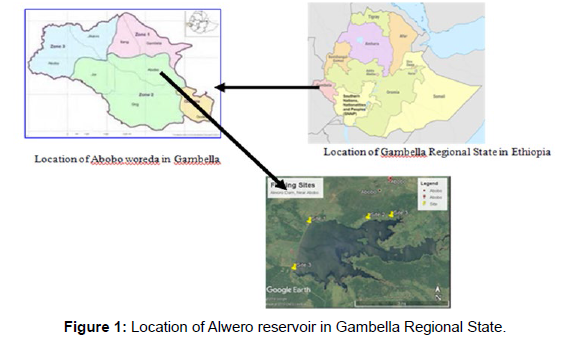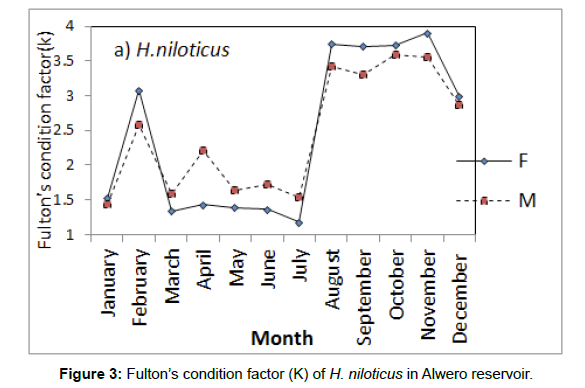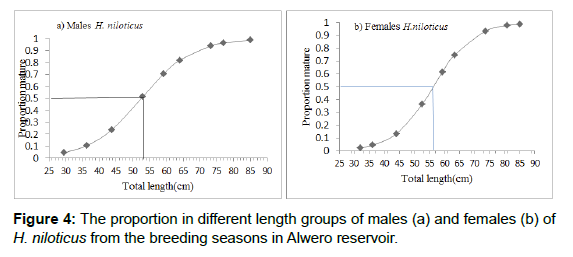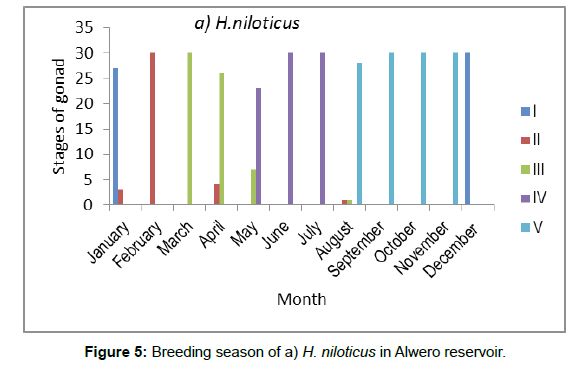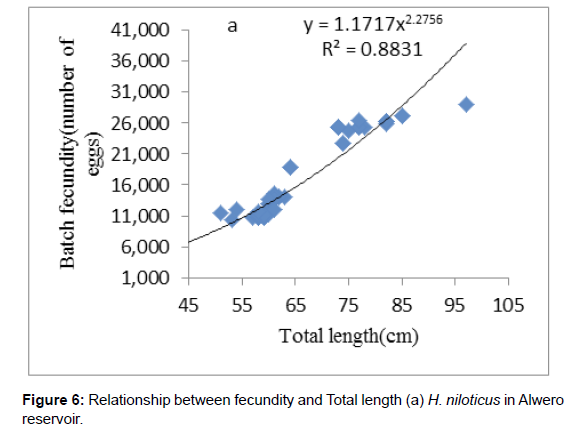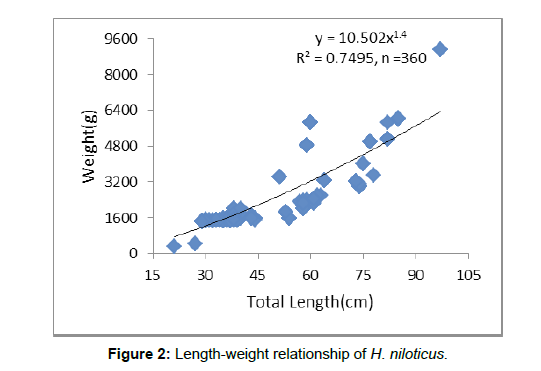Reproductive Biology of Heterotis niloticus (Cuvier, 1829) in Alwero Reservoir, Gambella, Ethiopia
Received: 26-Jan-2023 / Manuscript No. JFLP-23-87950 / Editor assigned: 28-Jan-2023 / PreQC No. JFLP-23-87950(PQ) / Reviewed: 11-Feb-2023 / QC No. JFLP-23-87950 / Revised: 16-Feb-2023 / Manuscript No. JFLP-23-87950(R) / Accepted Date: 18-Feb-2023 / Published Date: 23-Feb-2023 DOI: 10.4172/2332-2608.1000395
Abstract
This study was to investigate reproductive biology of Heterotis niloticus in Alwero Reservoir for better exploitation of fish resources which was conducted on monthly basis from December 2020 to November 2021 to know Length-weight relationships, sex ratios and size at first maturity of H. niloticus. Gillnets of 11 different mesh sizes (4, 6, 8, 10,12,14,16,18,20,22 and 24 cm) were used to sample the fishes. Total Length (TL) and total body weight (TW) of H. niloticus were measured to the nearest 0.1 cm and 1 g, respectively. The results of the study showed that the length-weight relationships for H. niloticus (TW = 10.502TL1.4; n =360; r2 = 0.749) and showed a curvilinear relationship, signifying the fishes growth were negative allometric growth, insignificant difference between sexes (P<0.05). The size at first sexual maturity (L50) for H. niloticus females 56.20 cm TL and 52.57 cm TL for males. H. niloticus have an extended breeding period from March to August, with peak spawning in June and July. The main intense in breeding activity occurred during the rainy months of April to August. The mean numbers of eggs per female were 19,698.5 eggs for H. niloticus, with total length range from 44 to 97 cm TL. Fecundity had a significant correlation (P<0.05) with both somatic weight and total length. Based on growth parameters indicated that the fish population is normal fish population with no apparent problems of over exploitation, although there is report in size reduction of fish by fishers. Unregulated open access resource use, illegal use of gillnets and uncoordinated water resources development activities existed.
Keywords
Alwero reservoir; Fecundity; Length-weight relationship; Sex ratio; Size at first Maturity
Introduction
Reproduction is a crucial stage in the life cycle of a fish that determine the demographic balance of a fish species [1 ]. It’s associated with habitat differences, fish species type, differences in body condition and growth. Heterotis niloticus is a fish in the Osteoglossidae family. They distributed in White Nile system and Omo-Turkana in Ethiopia [2]. White Nile system includes Baro River, Alwero River, Gilo River, Akobo River, Pibor River and their tributaries and floodplain in Gambella regional state.
Heterotis niloticus has a high aquaculture potential due to its strong growth, its double breath, the good taste quality of its flesh and its relative high commercial value [3]. In the Alwero Reservoir, it is exploited from regularly by the artisanal fishery. Heterotis niloticus is the 2nd fish species commonly seen in the market next to tilapia [4].
Understanding of the breeding and fecundity of commercially important fishes is critical and can provide basic knowledge for the conservation and fish resources management. However, such knowledge is not recently available for the species in the Gambella water bodies in general and Alwero reservoir in particular; and this has hindered proper management of the fishery. Therefore, the objectives of this study was to determine breeding season, size at first maturity (L50), length-weight relationship, condition factor, fecundity and sex ratio of Heterotis niloticus in Alwero reservoir with the aim of providing basic information for proper utilization and management of the stock.
Materials and Methods
Study site
Alwero reservoir is located in the Abobo Woreda (7052’19.2’’ N; 34029’56.4’’ E) at an altitude of 450 m, which is about 824 km Southeast of Addis Ababa (Figure 1). It has a surface area of about 74 km2 [5].It has a tremendous resource regarding fish production that reaches an average of 144 tons of fish annually which created invaluable job opportunities for the surrounding community [6]. Three Sampling station, Kano, Gidip and Zero were selected purposively based on vegetation cover, human and animal interference intensity.
Sample collection and measurements
Experimental fishing was conducted monthly from December 2020 to November 2021 using multifilament gillnets of different stretched mesh sizes (4, 6, 8, 10, 12, 14, 16, 18, 20, 22 and 24 cm) made of 210 D/15 twines. Immediately after harvest, fishes were identified into species, Total Length (TL) for rounded and truncated caudal fine fishes (e.g. O. niloticus and C. gariepinus) and Fork Length (FL) for forked caudal fin fishes (e.g. B. docmac, C. carpio and L. intermedius) were measured to the nearest 0.1 cm and total weight to the nearest 0.1 g. Sexes of the harvested fishes were determined by inspecting visually and by dissecting the gonads for some biological parameter analysis. A five-point maturity scale was used to describe stages of gonads [7]; Immature - I; Developing - II; Maturing (and/or recovering for females) - III; Mature (and/or recovering for males) - IV; Ripe - V; Ripe running - VI; Spent (for females only)-VII. Males were graded into six stages because their gonads contained running milt most of the time and the spent condition was not distinct. The female gonads go through a well-defined stage of recovering. Recycling females of Stage III were designated as III R. The ovaries of Heterotis niloticus were split longitudinally and turned inside out, to ensure the penetration of the preservative before storing in labeled jars [8] and they were preserved in Gilson’s fluid [9]. The preserved samples were then transported to the laboratories at Bahir Dar University College of Agriculture and Environmental Sciences for laboratory analysis.
Length-Weight Relationship and Condition Factor: The relationship between total length and total weight of the fishes were calculated using least squares regression analysis [8] as follows: TW = aTLb, for total length. Where: TW-Total weight in grams, TL-Total length in centimeters, a - Intercept of the regression line and b-Slope of the regression line.
The condition or well-being of the species was determined by computing Fulton Condition Factor suggested by Bagenal and Tesch [8].

Where: FCF - Fulton condition factor, TL-Total length in centimeters and TW-Total weight in grams
Estimation of Sex-Ratio: The numbers of female and male individuals were recorded for each sampling occasion. Sex- ratio (Female: Male) were then calculated for each fish species of the total sample. Chi-square test was employed to test if sex ratio varied from one-to-one in the total samples for each species as in Demeke Admassu (1994).

Determination of Breeding Season: The breeding season of Heterotis niloticus were determined from monthly frequency of fish with ripe gonads and gonado-somatic index (GSI). The GSI for each fish was computed as the weight of the gonads in percent of total body weight and GSI were calculated using the formula employed by Marcano [10], Sarkar [11], and Gupta and Banerjee [12].

Estimation of Length at Fish Maturity (L50): The average length at first maturity (L50) has been defined as the length at which 50% of the individuals in a given length class reach maturity [13]. Thus, after classifying data by length class, the percentages of male and female Heterotis niloticus with mature gonads were plotted against length to estimate L50 graphically [14]. Thus, Lm50 were estimated from the relationship between the percentages of mature fish (P) of length class (L) as described by the logistic function [15]:

and the value of Lm50 was estimated using the following equation:

Where, α and β was estimated using Marquardt’s [16] algorithm of non-linear least squares regression.
Fecundity Estimation: Fecundity is the number of eggs produced per female per unit time (e.g., per spawning season). The fecundity of ripe gonads preserved in Gilson’s fluid was estimated gravimetrically [17]. Thus, for each fish species, the numbers of eggs in three subsamples of eggs each weighing 1 g, were determined from which average number of eggs per gram of ovary will be calculated. The weight of all the eggs in ovaries was also calculated. Fecundity as total number of eggs per ovary (F) was then estimated for each fish species as in:

Where, W=Weight of all eggs n=Average number of eggs per gram w=Weight of sub-samples of eggs (=1g)
In addition, relative fecundity as number of eggs per ovary weight as well as per total body weight was also calculated.
Data analysis
The length frequency distributions were used to describe the size
structure of the fish, using the computer packages MS-Excel 2010 and
SAS version 9. Mann-Whitney U test were used to analyze condition
factor. Their maturity was identified by examining the gonads, and
gonadal development will be staged in order to identify seasonal
maturational cycles. The size at sexual transition was estimated by
examining the size range in which males overlapped with females. The
median value and its confidence limits were taken to represent the size at
which sex change occurs. The timing of the spawning season was studied
using the appearance of the gonads according to the predefined stages
of maturation over time. Length-weight relationships were obtained using the log linear regression model where WT is the weight in grams, LT is the total length in centimeters, log a is
the intercept of the regression model, and b is the regression coefficient.
The relationship between fecundity and some morphometric
measurements (TL, TW and ovary weight) were determine using least
squares regression. The size at sexual maturity (L50) of females were
estimated by fitting a logistic regression function, available from SAS
version 9, to the proportion of mature fish in 5 cm size categories. The
overall male to female sex ratio was calculated for the whole sample
size at 5 cm class intervals. A two-sample independent-test will be used
to determine the differences in size between females and males. For all
statistical tests that were conducted, the level of significance will be set
to P < 0.05.
where WT is the weight in grams, LT is the total length in centimeters, log a is
the intercept of the regression model, and b is the regression coefficient.
The relationship between fecundity and some morphometric
measurements (TL, TW and ovary weight) were determine using least
squares regression. The size at sexual maturity (L50) of females were
estimated by fitting a logistic regression function, available from SAS
version 9, to the proportion of mature fish in 5 cm size categories. The
overall male to female sex ratio was calculated for the whole sample
size at 5 cm class intervals. A two-sample independent-test will be used
to determine the differences in size between females and males. For all
statistical tests that were conducted, the level of significance will be set
to P < 0.05.
Results
Length-weight relationship and condition factor
A total of 360 specimens from Heterotis niloticus (n=360) in Alwero reservoir were caught for the study of biological parameters using gillnets mesh sizes (4, 6, 8, 10,12,14,16,18,20,22 and 24 cm). The total length of H. niloticus range from 44-97 cm TL with their corresponding total weight range from 1400 to 9100 gm.
Length-weight relationships were determined for Heterotis niloticus in Alwero reservoir was curvilinear and statistically highly significant (P < 0.05). The line fitted to the data for H. niloticus (both sexes) described by the regression equations shown in Figures 2. An equation combined for fish ranging in length from 44 - 97 cm TL (H. niloticus), and the corresponding total weight from 1400 to 9100 gm.
Fulton Condition Factor (FCF) values (mean ± SE) of the H. niloticus were 2.44±0.08 for both sexes and for the separate sexes (2.42±0.11 for females and 2.47±0.11 for males). Average monthly Fulton’s condition factor (K) of H. niloticus for both sexes were fitted and shown in Figures 3. The results were found to be significantly different between months (ANOVA, P<0.05). Lower values of k were observed during January and July for male and female respectively (Figure 3) which seems to match with the peak breeding season of the fish and decrease of water level. However, no significant difference was observed between sexes (ANOVA, P > 0.05).
Estimation of sex-ratio
Sex ratio of the H. niloticus is presented in Table 1. Females were more frequent than males in Alwero reservoir. The sex ratios of H. niloticus were insignificantly different from the hypothetical distribution of 1:1 (P >0.05) (Table 1).
| Fish species | Total | Females | Males | F:M | Chi-square |
|---|---|---|---|---|---|
| H. niloticus | 360 | 192 | 168 | 1:1.14 | 0.2059 |
Table 1: Sex ratio of H. niloticus, G. niloticus, B. bajad and O. niloticus at Alwero reservoir.
Estimation of length at fish maturity (l50)
The L50 of fishes were found to be 56.20 cm TL and 52.57 cm TL for female and males H. niloticus, respectively (Figure 4). Based on the current study, on average males attain sexual maturity at relatively smaller size than females at Alwero reservoir.
Determination of breeding season
The breeding season of H. niloticus were determined from percentages of fish with ripe gonads taken monthly from December 2020 to November 2021. Fish that had immature gonads (Stages I and II) were found in January, February, April and August for H. niloticus. Fish that were still developing (Stage III) occurred in March to May and peak March. Fully matured gonads (Stage IV) were observed from May to July and peak in June for H. niloticus. Fish with spent gonads (Stage V) were found in August to November, August to October and July to October for H. niloticus (Figure 5). The gonadosomatic index (GSI) for females H. niloticus ranged between 0.61% and 2.40% with a mean of 1.50% ± 0.05%.
Fecundity estimation
Fecundity of H. niloticus was range between 10,430 to 28,967 eggs with average of 19,698.5 eggs, with correspondent total length range from 44 to 97 cm TL. Fecundity had a significant correlation (P<0.05) with both somatic weight and total length for H. niloticus in Alwero reservoir. The relationship between fecundity and total length, total weight and gonad weight were shown in Fig.6. Fecundity showed an increase with the increase in size of the fish and ovary weight (Figure 6).
Discussion
Length-weight relationship and condition factor
The relationship between Total length and total weight for H. niloticus in Alwero reservoir was curvilinear and statically significant (Figures 1). This agrees with other works in tropical lakes and reservoirs [18]. The regression coefficient of H. niloticus in this study is (b=1.39) which show negative allometric growth in Alwero reservoir unlike positive allometric growth Patten report by Gatriay Tut [19] in Gilo River (b=3.03) and wetlands (b= 3.58) for both seasons in Gambella region. Similarly, disagree with the finding of Ezekiel and Abowei, [20] in Amassoma flood plain (b=3.17). However, these findings agree with report of Olanrewaju [21] in Lake Alau (b=1.80) that indicate negative allometric growth.
The Fulton’s condition factor (K) indicates the relative plumpness or degree of well-being of the fish. The average K value of H. niloticus (2.44±0.08) in Alwero reservoir is higher than values reported for the same fish species H. niloticus (0.75 ± 0.16 and 0.79 ± 0.19) from Gilo river and wetlands respectively in Gambella region [19]. Generally high mean condition factor for H. niloticus indicates good condition of fishes throughout the study period at Alwero reservoir. Agree with Pauker and Rogers, [22] that indicate higher body condition is correlated with high energy content, adequate food availability, and reproductive potential and favourable environmental conditions.
Average monthly Fulton’s condition factor (K) of H. niloticus fish species for both sexes were fitted and shown in Figures 2. The results were found to be significantly different between months (ANOVA, P<0.05). Lower values of k were observed during January and July for male and female H. niloticus respectively (Figure 2) which seems to match with the peak breeding season of the fish and decrease of water level. However, no significant difference was observed between sexes (ANOVA, P > 0.05).
Estimation of Sex-Ratio
The overall sex ratio of H. niloticus was not significantly different from 1:1 (P > 0.05) in the present study. Female dominant sex ratios (1: 1.17; X2= 0.20593; p > 0.05) were seen for H. niloticus at Alwero Reservoir (Table 1). This agrees with the results obtained for the same species in Agneby River [23]. However, male dominant sex ratios over female H. niloticus were reported in Anambra River, Nigeria [24]; and in Lake Hlan and Soˆ River [25]. The unequal sex ratio found in the present study for H. niloticus was probably attributable to behavioural differences between the sexes (growth rate, differences maturity rates, mortality rates, or migratory patterns) between the sexes which might have made females more vulnerable to be caught in passive or active (chest & traps) gears like gill nets. According to Matsuyama [26] unequal sex ratios between the male and female sexes could be caused by other biological mechanisms like differences maturity rates, mortality rates, or migratory patterns of fish. In addition, preponderance of females has been attributed to sexual separation during spawning activity, gear type and fishing site for O. niloticus in Lake Hawassa [27]. Further study is required to see if the same factors could be responsible for sex ratio in the Alwero reservoir fish species.
Determination of breeding season
The smallest male found with ripe gonads was 44cm TL and 1582 g., while the smallest female in breeding condition was 51 cm TL and weighed 3430 g for H. niloticus. The extended breeding period of 5 to 6 months (March to July for H. niloticus) could be a strategy to ensure that their offspring reach a relatively bigger size that places them in a better position to predate on fry and fingerlings of other fish species that would breed later in the year. Extended intense breeding seasons (May to August) for H. niloticus were documented by [25] in the Soˆ River-floodplain system. Generally the breeding of most tropical fishes occurred during rainy season when physicochemical conditions of the aquatic environment are favourable [28, 29], although continuous all year round breeding has been reported in some tropical fish species like O.niloticus in Fincha reservoir [30] which is similar trend at Alwero resevoir. Fully matured gonads were observed from May to July and peak in June and July for H. niloticus. This finding partially agreed with the work of Kouakou [23] for H. niloticus which stated that fully matured gonads were observed from June to august and from November to December.
Estimation of Length at Fish Maturity (L50)
The information of knowing sexual maturity is useful to identify sizes that fish are capable to produce, optimum age of first capture of fish species, time and place of spawning. The sizes at 50% maturity of H. niloticus in current study were 56.20 cm for females and 52.27 cm for males which were higher than those reported by Kouakou [23] for the species in Agneby River (43.63 cm for males and 48 cm for females). Nearly similar with finding of Adite [25] stated that the size at which 50% of individuals were mature was about 57.5 cm TL for both sexes of H. niloticus from the Soˆ River–Lake Hlan system.
Fecundity estimation
The fecundity recorded in this study varied between 10,430 to 28,967 eggs with average of 19,698.5 eggs for H. niloticus suggesting that the species has medium fecundity. This finding in agreement with the report of Kouakou [23] who recorded an average of 15,507.5 of eggs for H. niloticus. High parental care fish species are exhibit low fecundity characterizes [31]. The significant correlation (P<0.05) of fecundity with both somatic weight and Total length suggests that fecundity increases with increase in weight and length of H. niloticus at Alwero reservoir. According to King, [32] the number of eggs produced increased as the body weight of fish increased, whereas Shinkafi [33] reported insignificant correlation in the length and fecundity.
Conclusions and Recommendations
The aim of this study was to investigate the reproductive biology of H. niloticus for better exploitation of resources in Alwero Reservoir. This study revealed that the length-weight relationship of H. niloticus was curvilinear and statistically significant, showed a negative allometric growth which implies that the fish species they tend to become thinner as they grow larger. High mean condition factor recoded for H. niloticus indicates good condition of fishes throughout the study period at Alwero reservoir. It was found to be different between months but not between the sexes. H. niloticus in Alwero Reservoir followed the general pattern of breeding behavior in tropical water bodies were relatively higher proportions of fish were in breeding condition during the onset of the rainy season when there is high flooding. Females were more frequent than males, males H. niloticus matured at smaller size than female in Alwero reservoir. Indeed capture size of the stock should be determined taking into account the L50 of females, which may otherwise remove the spawning fish during their peak breeding season. However, we recommend the fishers have to use gillnets greater than 12 cm stretched mesh size for H. niloticus to ensure sustainable utilization of the stock in Alwero reservoir. A closed season is recommended during the peak breeding period for H. niloticus. The results of this study have therefore provided baseline information which could enhance production potential of this fish species and its sustainable development and management in Alwero Reservoir.
Declaration
Author’s contribution statement Ojuni Odier, Minwyelet Mingist, Gashaw Tesfaye and Adamneh Dagne conceived and designed the experiments; performed the experiments; analyzed and interpreted the data; contributed reagents, materials, analysis tools; and wrote the paper.
Funding statement
This work was supported financially and materially by the Ethiopian Institute of Agricultural Research (EIAR) and partially by Gambella University.
Data availability statement
The data that has been used is confidential.
Declaration of interested statement
The authors declare that no conflict of interests.
Additional information
No additional information is available for this paper.
Acknowledgement
The authors thank Minwyelet Mingist, Gashaw Tesfaye and Adamneh Dagne for technical advising assistance. This work was supported financially and materially by the Ethiopian Institute of Agricultural Research (EIAR). The authors also thank Gambella University and Bahir Dar University for the chance given and hosting as a PhD student respectively.
References
- Parkinson D, Petit F, Perpinien G, Philippart JC (1999) Breeding habitats fish and geo-morphological processes in Bottom Rivers stony. Synthesis test and applications to some rivers of the basin of the Meuse. Bulletin of the Geographical Society of Liège 31-52.
- Golubtsov AS, Darkov AA (2008) A Review of Fish Diversity in the Main Drainage Systems of Ethiopia Based on the Data Obtained by 2008. Addis Ababa 69–102.
- Mamadou O (2009) Reproduction De Heterotis Niloticus (Cuvier, 1829) De La Riviere Agneby (Cote d’Ivoire). Eur Sci J 12: 1-14.
- Odier O, Mingist M, Tesfaye G, Dagne A (2021) The Status of Fisheries in Gambella Region. In: Fekede Feyissa, Temesgen Jembere, Getu Kitaw and Getahun Kebede (eds) Results of Livestock Research Proceedings Completed in 2021 EIAR, Addis Ababa 493-509.
- Tesfaye G, Wolff M (2014) The state of inland fisheries in Ethiopia: a synopsis with updated estimates of potential yield. Integr Med Res 14: 200-219.
- Abegaz H, Tesfaye G, Cheffo A (2010) Fishery Development Program: Riverine Fishery Assessment in Gambella Peoples' Regional State, Ethiopia: 79.
- Holden MJ, Raitt DFS (1974) Manual of fisheries science Part 2. Methods of resource investigation and their application. FAO Fisheries Technical Paper 1: 223.
- Bagenal TB, Braum E (1978) Eggs and early life history In: Methods for assessment of fish production in freshwaters. IBP Hand book 3, Blackwell Scientific, Oxford 165-201.
- Simpson A (1959) Method used for separating and counting the eggs and fecundity studies on the plaice (Pleuronectes platessa) and herring (Clupea herengus). Occ Pap FAO indo-pacif fish coun N0. 59112.
- Marcano D, Cardillo E, Rodriguez C, Poleo G, Gago N, et al. (2007) Seasonal reproductive biology of two species of freshwater catfish from the Venezuelan floodplains. Gen Comp Endocrinol 153: 371-377.
- Sarkar U, Kumar R, Dubey V, Pandey A, Lakra W (2012) Population structure and reproductive biology of a Freshwater Fish, Labeoboggut (Sykes, 1839) from two perennial rivers of Yamuna Basin. J Applied Ichthyology 28: 107-115.
- Gupta S, Banerjee S (2013) Studies on some aspects of the reproductive biology of Amblypharyngodon mola. Int J Biol Sci 2: 69-77.
- Willoughby N, Tweddle D (1978) The ecology of the catfish Clarias gariepinus andClarias senegalensis in the Shire Valley, Malawi. J Zool Lond 186: 507-534.
- Tweddle D, Turner J (1977) Age, growth and natural mortality rates of some cichlid fishes of Lake Malawi. J Fish Biol 10: 385-398.
- Echeverria TW (1987) Thirty-four species of California rockfishes: maturity and seasonality of reproduction. Fish Bull 85: 229-250.
- Donald W. Marquardt (1963) An Algorithm for Least-Squares Estimation of Nonlinear Parameters. SIAM J Comp 11: 431-441.
- Mark Snyder (1983) The influence of individuals on situations: Implications for understanding the links between personality and social behavior. J Pers 51: 497-516.
- Teferi Y, Admassu D (2002) Length-weight relationship, Body Condition and Sex ratio of tilapia (O. niloticus) in Lake Chamo, Ethiopia. SINET: Ethiop J Sci 25: 19-26.
- Tut G, Wakjira M, Tamire G (2019) Diversity, Length-Weight Relationship and Condition Factor of Fishes in Gilo River and its Nearby Wetlands in Akobo District, Gambella Region, Ethiopia. J Fisheries Sciences 13: 019-028.
- Ezekiel EN, Abowei JFN (2013) Length-Weight Relationship and Condition Factor of Heterotis niloticus from Amassoma flood plain, Niger Delta, Nigeria. App Sci Report 4: 164-172.
- Olanrewaju AN, Kareem OK, Nyaku RE, Tubo MT (2017) Length-Weight and Length-Length Relationships of Heterotis niloticus (Cuvier, 1829) and Raiamas senegalensis (Steindachner, 1870). J Aquac Res Development S2: 011.
- Pauker C, Rogers RS (2004) Factors affecting condition of Flanmelmout Suckers in Colorado River, Grand Canyon, Arizona. North Am J Fish Manage 24: 648-653.
- Kouakou, Nanga SN, Plagne-Ismail C, Pali AM, Ognakossan KE (2016) Cassava: production and processing. ISF Cameroun, CTA 1-41.
- Odo GE, Ejikeme G, Nwamba, Helen Ogochukwu NH, Eyo, et al. (2009) Aspects of the Biology of Heterotis niloticus Cuvier 1829 (Osteoglossiformes: Osteoglossidae) in the Anambra Flood River System, Nigeria. Anim Res Int 6: 994–1002.
- Adite A, Winemiller KO, Fiogbe´ ED (2006) Population structure and reproduction of the African bonytongue Heterotis niloticus in the Soˆ River floodplain system (West Africa): implications for management. Ecol Freshw Fish 15: 30–39.
- Matsuyama M, Adachi S, Nagahama Y, Matsuura S (1988) Diurnal rhythm of oocyte development and plasma steroid hormone levels in the female red sea bream during the spawning season. Aquaculture 73: 357-372.
- Demeke Admassu (1994) The breeding season of tilapia, Oreochromis niloticus L. in Lake Awassa (Ethiopian rift valley). Hydrobiologia 337: 77–83.
- Admassu D, Abera L, Tadesse Z (2015) Fecundity and Breeding Season of the African Catfish, Clarias Gariepinus (Burchell), in Lake Babogaya. GJAAS 3: 295-303.
- Tesfahun A (2019) Breeding seasons of some commercially important fishes in Ethiopia: Implications for fish management. Academic journal 14: 9-14.
- Degefu F, Tesfaye G, Tefera F (2012) Study on the Adaptability Status and Reproductive Success of Oreochromis niloticus L. (Pisces: Cichlidae) and Carp (Cyprinus carpio L., 1758) in a Tropic Reservoir (Fincha, Ethiopia). Int J Aquac 2: 65-71.
- Yirgaw T, Demeke A, and Seyoum M (2001) Breeding season, maturation and fecundity of Oreochromis niloticus L (Pisces: Cichlidae) in Lake Chamo, Ethiopia. E J Sci 24: 255-264.
- King RP (1997) Length–fecundity relationship of Nigeria fish population. ICLARM Quarterly 20: 29-33.
- Shinkafi BA, Mamman T (2011) Gonadosomatic index, fecundity and egg size of S. eupterus (Boulenger) in River Rima, North-Western Nigeria. Proceedings of the 26th Annual Conference of the Fisheries Society of Nigeria, Minna, Nigeria 135-143.
Google Scholar, Crossref, Indexed at
Google Scholar, Crossref, Indexed at
Google Scholar, Crossref, Indexed at
Google Scholar, Crossref, Indexed at
Google Scholar, Crossref, Indexed at
Google Scholar, Crossref, Indexed at
Google Scholar, Crossref, Indexed at
Google Scholar, Crossref, Indexed at
Google Scholar, Crossref, Indexed at
Google Scholar, Crossref, Indexed at
Citation: Odier O, Mingist M, Tesfaye G, Dagne A (2023) Reproductive Biologyof Heterotis Niloticus (Cuvier, 1829) in Alwero Reservoir, Gambella, Ethiopia. JFisheries Livest Prod 11: 395. DOI: 10.4172/2332-2608.1000395
Copyright: © 2023 Odier O, et al. This is an open-access article distributed underthe terms of the Creative Commons Attribution License, which permits unrestricteduse, distribution, and reproduction in any medium, provided the original author andsource are credited.
Select your language of interest to view the total content in your interested language
Share This Article
Recommended Journals
Open Access Journals
Article Tools
Article Usage
- Total views: 4666
- [From(publication date): 0-2023 - Nov 27, 2025]
- Breakdown by view type
- HTML page views: 4220
- PDF downloads: 446

